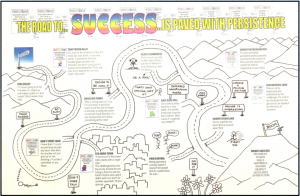Avoiding Avoidance in the Classroom
Recently a Principal asked me why he was seeing so many students going to the bathroom all day… there are of course many reasons – however I suggested it was possibly not an epidemic of incontinence, it is more likely to be an avoidance tactic.
Students can be extremely smart at avoiding doing anything that might be challenging, hard, difficult or simply outside of their comfort zone.
I asked a group of teachers to list the strategies their students use to avoid work? Here are some…
- Needing a drink of water
- Sharpening a pencil

- Helping someone else
- Looking busy
- Tidying up/cleaning up
- Starting a non-relevant conversation with the teacher
- Walking around the classroom looking for something
- Going to the cloakroom to get ‘something’
- Feeling sick (which is a real physiological response to stress)
- Offering to be a messenger for the office
- Telling the teacher that someone else is not doing their work!
- The list goes on…
When I asked the students in a school the same question they reiterated the above, and added a couple of my favourites:
- “I hide my pencil and then spend 15 minutes looking for it!”
- “I pretend to be writing and when the teacher comes close, I look like I’m thinking!”
 I believe one of the best ways to deal with avoidance is to address the ‘elephant in the room’ and simply talk about it. Make students aware that you know the behaviours they are exhibiting are about avoidance and then teach explicit strategies to overcome the avoidance.
I believe one of the best ways to deal with avoidance is to address the ‘elephant in the room’ and simply talk about it. Make students aware that you know the behaviours they are exhibiting are about avoidance and then teach explicit strategies to overcome the avoidance.
Just asking students to stay on task and persist is not enough. Christchurch Teacher and DP, Adrian Rennie, created a wonderful lesson and conversation for his class… The road to success is paved with persistence. Adrian has cleverly and accurately distilled the essence of success and avoidance strategies in this simple, yet powerful road map.
He talked to his students about getting caught in the side roads of Joke Valley, Temptation Alley, Boredom Town, Don’t Start Land, Too Hard Town, Class Clownville, Half Done Hill, Pain Central, Come Back Later, Competition Land, Mount Metacognition, Fascination Land and finally arriving at Mount Success. (Do these sound familiar?) Once having named the ‘elephant in the room’ students were acutely aware of their avoidance strategies and even coached each other. One student was overheard complaining he was bored. Quick as a flash, another turned and said, “Well you better get out of that town fast!”
Another strategy is simply naming the behaviour and offering support. For example: “You are doing x to avoid x, is there anything I can do to help you?”
I recently gave students a very challenging task as part of a model lesson series at an Australian school. I was upfront with them by explaining that they would find the activity difficult. In the middle of the lesson, a boy burst into tears. Before I could intervene, I overheard another child say, “It’s supposed to be hard.” The young boy looked up, shrugged, smiled and got back on with the task.
The use of metaphors for learning are important. I use the Monarch Butterfly as a  metaphor for why the struggle is important. The struggle to emerge from the chrysalis is how the butterfly wings become strong. If the butterfly is assisted out of the chrysalis, it will die. The struggle makes it strong. This is also true of our students. When we as teachers jump in and rescue learners too soon, we are denying them the chance to develop the muscles of problem solving, thinking and getting themselves unstuck next time.
metaphor for why the struggle is important. The struggle to emerge from the chrysalis is how the butterfly wings become strong. If the butterfly is assisted out of the chrysalis, it will die. The struggle makes it strong. This is also true of our students. When we as teachers jump in and rescue learners too soon, we are denying them the chance to develop the muscles of problem solving, thinking and getting themselves unstuck next time.
Other techniques that may assist to minimise the avoidance epidemic include;
- Teaching planning and time management techniques
- Ensuring the work students are doing is relevant, engaging and purposeful (Although not all work in life is like this- sometimes you just have to knuckle down and get on with it)
- Positive reinforcement
- Creating time for students to work on their own projects and passions
- Provide brain breaks
- Ensure students are hydrated
- Showing students their next learning steps
- Explicitly teaching focus strategies
- and again the list goes on…
In what ways do you positively deal with avoidance in your classroom?
Tags: avoidance, learning metaphor, persistence, strategies, Success
Published on Thursday, September 3rd, 2015, under Learning, Modern learning environment, Teacher Effectiveness


Thanks for your blog(s) they are very helpful and interesting and provoke a lot of thought. We are now teaching in the International school circuit and although the students and the curriculum might be different from back home (NZ) the issues can be the same.
Yes David – Universal issues… Where in the world are you teaching?
Rainbows and sunshine
Karen
Hi Karen, Im 24 and finally going back to college, and you cant believe what a help this article was in finding myself in my work. You cant believe how many hours I spend on netflix and various other tasks that have nothing to do with that “dreaded” homework. Its late, but Im learning how to get myself to start to enjoy learning and studying again.
Up until 4th grade I LOVED school and was learning so well, that the school wanted me to skip a grade but along with family stresses and moving to a different state, I lost it, and had ironically had to repeat a grade in high school.
My question is (as complicated as it may be in practice) how do you regain that focus, love for learning, and ease when doing school work. At this point, “homework” is just a big stressor that its virtually impossible for me to stay concentrated on one task until it gets done.
Thanks sooooo much for your blog and your help,
Sammy
Where can we find Adrian Rennie’s Lesson and “Road to Success” map? It looks very interesting and something that my class could do with.
I found you article to be spot on.
Thank you
Gertie Wetsteijn
Hi Gertie – I do not have a copy of the lesson. My suggestion is to create your own with your students, asking them which towns they get stuck in. Personalising it will be really powerful 🙂
Rainbows and sunshine
Karen
Yes, I too would like a downloadable map, then we could read through and make one of our own. I will keep looking but post the site if you find it! Cheers
Great read Karen, I go down those streets, visit those towns and alleys myself sometimes STILL! I like to remember the ease in which we learn -we learned to walk and talk-it just happened. I wonder why learners “can’t” or “won’t” when it is in their spirit to learn. Are they disengaging from the learning or from the activity?
A comprehensive list of techniques.
Best technique for me to positively deal with avoidance? Prevention…watching what my own children do at home to understand what is an authentic context and whether the learner sees the purpose. Then they “can” and “will”. Pinterest trawling is not for me but I have got my hands messy in Minecraft and similar. Getting to know what interests each learner? Building relationship. Seeing it through their eyes. Yes, sometimes you just have to knuckle down and get on with it but why do some find joy in the challenge and others not? I wish I had been allowed to go to the loo when I went to school! Thanks for the conversation.
Thanks for your comments Therese – maybe it has something to do with mindset, fear of failure or just lack on engagement. Plus just for the record – while I was writing the blog, I watched myself getting distracted, eating, drinking, checking emails… I was chuckling to myself!!
[…] do students do when they try to avoid work in the classroom? How do you avoid avoidance? Kids are experts at this. We need to recognise it, label it and challenge what they are avoiding. […]
[…] be comfortable with mistakes, they need to avoid avoidance. Karen talks about this extensively in this blogpost – it’s a great […]
Is there a way to order that road map picture/poster? I can’t read it but I would love to use it.
I have permission to use the photo, however not permission for people to copy it- hence the smallness of the text. Please adapt and use the concept = think about when your students go ‘off track’ and create side roads for these occasions – even have your students help design it!